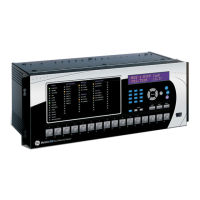GE Multilin B30 Bus Differential System 5-51
5 SETTINGS 5.2 PRODUCT SETUP
5
completely correct for uncompensated delay. A setting can be chosen that will reduce worst-case error to half of the
range between minimum and maximum uncompensated delay, if these values are known.
PORT 1 ... 3 PATH DELAY ASYMMETRY
• This setting corresponds to “delayAsymmetry” in PTP, which is used by the peer delay mechanism to compensate for
any difference in the propagation delay between the two directions of a link. Except in unusual cases, the two fibers are
of essentially identical length and composition, so this setting should be set to zero.
• In unusual cases where the length of the link is different in different directions, this setting should be set to the number
of nanoseconds the Ethernet propagation delay to the relay is longer than the mean of path propagation delays to and
from the relay. For instance, if it is known say from the physical length of the fibers and the propagation speed in the
fibers that the delay from the relay to the Ethernet switch it is connected to is 9 000 ns and the that the delay from the
switch to the relay is 11 000 ns, then the mean delay is 10 000 ns, and the path delay asymmetry is 11000 - 10000 =
+1000 ns.
c) SNTP PROTOCOL
PATH: SETTINGS PRODUCT SETUP REAL TIME CLOCK SNTP PROTOCOL
The B30 supports the Simple Network Time Protocol specified in RFC-2030. With SNTP, the B30 can obtain clock time
over an Ethernet network. The B30 acts as an SNTP client to receive time values from an SNTP/NTP server, usually a ded-
icated product using a GPS receiver to provide an accurate time. UR series relays support unicast, broadcast, multicast,
and anycast SNTP functionality.
The
SNTP FUNCTION setting enables or disabled the SNTP feature on the B30.
To use SNTP in unicast mode, SNTP SERVER IP ADDR must be set to the SNTP/NTP server IP address. Once this address is
set and SNTP FUNCTION is “Enabled,” the B30 attempts to obtain time values from the SNTP/NTP server. Since many time
values are obtained and averaged, it generally takes three to four minutes until the B30 clock is closely synchronized with
the SNTP/NTP server. It takes up to two minutes for the B30 to signal an SNTP self-test error if the server is offline.
To use SNTP in broadcast mode, set the SNTP SERVER IP ADDR setting to “0.0.0.0” and SNTP FUNCTION to “Enabled.” The
B30 then listens to SNTP messages sent to the “all ones” broadcast address for the subnet. The B30 waits up to 18 min-
utes (>1024 seconds) without receiving an SNTP broadcast message before signaling an SNTP self-test error.
The
SNTP UDP PORT NUMBER is 123 for normal SNTP operation. If SNTP is not required, close the port by setting it to 0.
When the
SNTP UDP PORT NUMBER is set to 0, the change takes effect when the B30 is restarted.
SNTP PROTOCOL
SNTP FUNCTION:
Disabled
Range: Enabled, Disabled
MESSAGE
SNTP SERVER IP ADDR:
0.0.0.0
Range: Standard IP address format
MESSAGE
SNTP UDP PORT
NUMBER: 123
Range: 0 to 65535 in steps of 1

